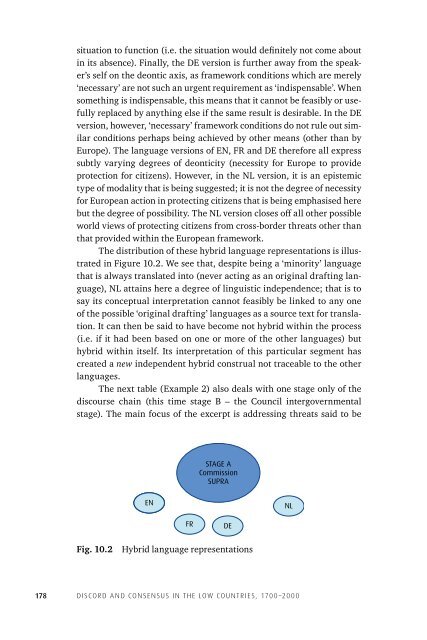Discord Consensus
7aze300jFJo
7aze300jFJo
Create successful ePaper yourself
Turn your PDF publications into a flip-book with our unique Google optimized e-Paper software.
situation to function (i.e. the situation would definitely not come about<br />
in its absence). Finally, the DE version is further away from the speaker’s<br />
self on the deontic axis, as framework conditions which are merely<br />
‘necessary’ are not such an urgent requirement as ‘indispensable’. When<br />
something is indispensable, this means that it cannot be feasibly or usefully<br />
replaced by anything else if the same result is desirable. In the DE<br />
version, however, ‘necessary’ framework conditions do not rule out similar<br />
conditions perhaps being achieved by other means (other than by<br />
Europe). The language versions of EN, FR and DE therefore all express<br />
subtly varying degrees of deonticity (necessity for Europe to provide<br />
protection for citizens). However, in the NL version, it is an epistemic<br />
type of modality that is being suggested; it is not the degree of necessity<br />
for European action in protecting citizens that is being emphasised here<br />
but the degree of possibility. The NL version closes off all other possible<br />
world views of protecting citizens from cross-border threats other than<br />
that provided within the European framework.<br />
The distribution of these hybrid language representations is illustrated<br />
in Figure 10.2. We see that, despite being a ‘minority’ language<br />
that is always translated into (never acting as an original drafting language),<br />
NL attains here a degree of linguistic independence; that is to<br />
say its conceptual interpretation cannot feasibly be linked to any one<br />
of the possible ‘original drafting’ languages as a source text for translation.<br />
It can then be said to have become not hybrid within the process<br />
(i.e. if it had been based on one or more of the other languages) but<br />
hybrid within itself. Its interpretation of this particular segment has<br />
created a new independent hybrid construal not traceable to the other<br />
languages.<br />
The next table (Example 2) also deals with one stage only of the<br />
discourse chain (this time stage B –the Council intergovernmental<br />
stage). The main focus of the excerpt is addressing threats said to be<br />
STAGE A<br />
Commission<br />
SUPRA<br />
EN<br />
NL<br />
FR<br />
DE<br />
Fig. 10.2<br />
Hybrid language representations<br />
178<br />
DISCORD AND CONSENSUS IN THE LOW COUNTRIES, 1700–2000


